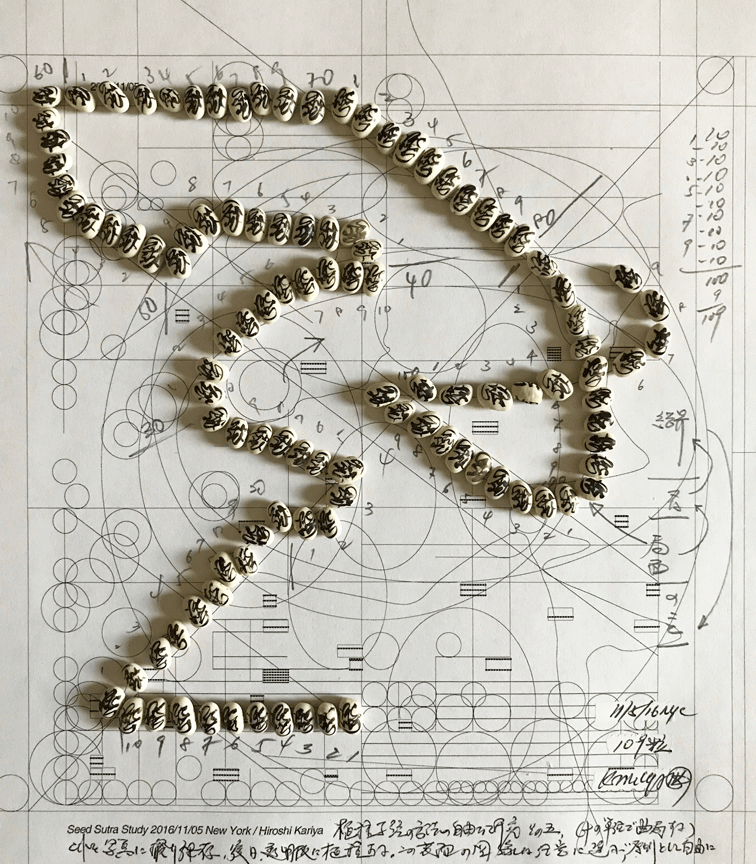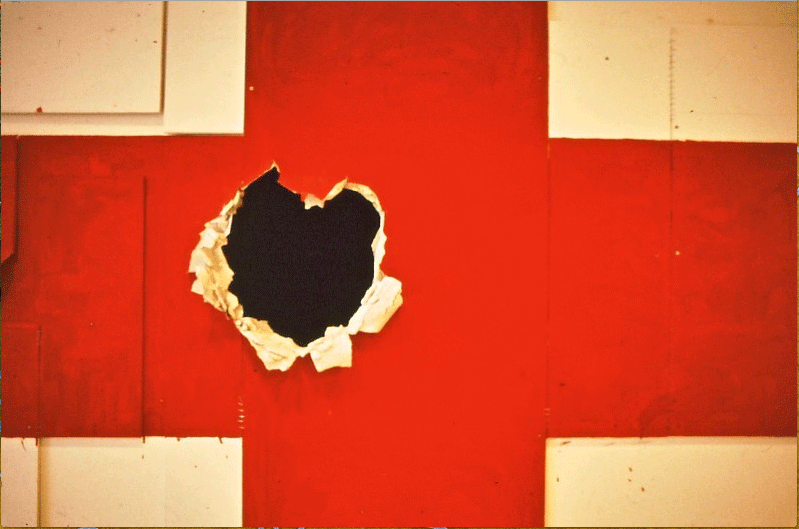Planting the seed
Planting the seed of an idea in the here and now By Miki Miyatake Nishizawa
on Hiroshi Kariya’s “Empty”exhibition at Mizuma Art Gallery, Tokyo
The Japan Times/ Saturday, May 11, 1996/ page 15 “The now is the now is the now is the now is the...” Hiroshi Kariya continues to write this phrase daily. Handwritten with a calligraphy brush, it looks like a Buddhist sutra. In Buddhist thought, the idea of “the now” signifies that living beings should live each single moment of “now”. A string of “now and now and now...” constitutes the whole history of the universe. Kariya writes “the now is sutra” on both sides of a dried bean, going through about 100 beans every night before going to bed. He keeps the finished beans in plastic bags with notes of his daily thoughts. For him, it is similar to meditation, a practice of being present in the now. For Kariya, creating art is not separate from his daily chores. Taking each breath could be an exercise of art, and living itself is art.

Three days before the opening day of his current exhibition at Mizuma Art Gallery in Aoyama, Tokyo, he started writing in chalk “the now is the now is the...” in spiral from the center of the concrete floor. The periphery of the circle is lined with pieces of limestone from Michigan bearing the words “the now is...” written in a spiral of tiny letters. The writing, which starts from the center of one side of a stone, makes its way clockwise, coiling to the other side of the stone. The beginning and the end of the writing are connected by Kariya piercing a hole in the middle of the stone. The idea that “there is no beginning and no end” signifies eternity, while at the same time it has a limit as one object.
Going clockwise follows Buddhist custom-a pilgrimage circuit of Buddhist temples in one area is supposed to be done clockwise. The loop without the end seems to be symbolic of reincarnation and the universe where everything is rotating in transformational stages repeating life and death.

“The now is sutra” is engraved on a thick candle placed at the north point of the circle of the text on the floor as well as on glass bowl containing water placed at the south end. Fire melts the candle and water evaporates from the bowl, and “this transformation fuses with the space at present,” says Kariya. The whole piece visually presents the universe in miniature with an incantation-like spiral text in the middle. Kariya’s practice of writing on dried beans in January and February 1992 is recorded in two booklets entitled “One day one piece one grasp seed sutra.” On each page, a fourline stanza written by Kariya is printed with the number of beans he scribbled that day along with date and place. Based in Brooklyn, N.Y., his poem was first in English: One piece of Brahma Day One Piece of ‘the now is’ One Piece of 8,640,000,000 years One Grasp of 104 pieces (January 18, 1992, Studio, Brooklyn, N.Y.) His interest and concern expressed in his poems shifted from the conflicts in various parts of the world to a more personal one as he traveled to his hometown Kamaishi in Iwate Prefecture to see his mother, ill with cancer. The poems he wrote during his stay in Japan frequently contain kanji characters meaning “pain, mother, me, breathe, dream, explain, morning, fear.”
Kariya’s love for his mother and his suffering over her pain permeate the poems. His writing the seed sutra every night for her recovery and also a means to soothe his feelings. What Kariya does looks simple, but the visual and spiritual impact of his writings are striking. The magical power of incantation is present, and his ritualistic manner of creation is convincing.
Barefoot, with his hair tied in a pony tail and writing “the now is sutra” on the floor, Kariya may remind us of a lordless samurai living with a Zen priest’s peaceful state of mind. He appears undisturbed by the overwhelming pace of the outer world.
It is interesting to see Kariya’s Japanese identity, his gracious attitude and power preserved even after living in New York for close to 20 years. He is very much in touch with himself, and it is obvious that his art work comes from the core of his being. As long as he lives, he will use his hands and mark the path of his life. By Miki Miyatake on Hiroshi Kariya’s “Empty” exhibition at Mizuma Art Gallery (J), Tokyo The Japan Times/ Saturday, May 11, 1996/ page 15 ©1996-2007 Hiroshi Kariya & Miki Miyatake Nishizawa
















